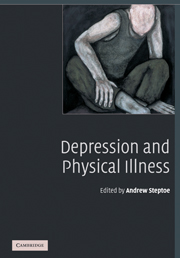Book contents
- Frontmatter
- Contents
- List of contributors
- Preface
- Part 1 Introduction to depression and its determinants
- Part 2 Depression and specific health problems
- Part 3 Biological and behavioural processes
- 12 Inflammation, sickness behaviour and depression
- 13 The hypothalamic–pituitary–adrenal axis: cortisol, DHEA and mental and behavioural function
- 14 Depression and immunity: biological and behavioural mechanisms
- 15 Smoking and depression
- 16 Depression and physical activity
- 17 Depression and adherence to medical advice
- Part 4 Conclusions
- Index
- References
13 - The hypothalamic–pituitary–adrenal axis: cortisol, DHEA and mental and behavioural function
from Part 3 - Biological and behavioural processes
Published online by Cambridge University Press: 17 September 2009
- Frontmatter
- Contents
- List of contributors
- Preface
- Part 1 Introduction to depression and its determinants
- Part 2 Depression and specific health problems
- Part 3 Biological and behavioural processes
- 12 Inflammation, sickness behaviour and depression
- 13 The hypothalamic–pituitary–adrenal axis: cortisol, DHEA and mental and behavioural function
- 14 Depression and immunity: biological and behavioural mechanisms
- 15 Smoking and depression
- 16 Depression and physical activity
- 17 Depression and adherence to medical advice
- Part 4 Conclusions
- Index
- References
Summary
Introduction
Steroids are an extensive family of chemical agents distributed widely in the brain. They include the classical stress hormone cortisol, oestradiol, testosterone and progesterone (collectively known as the sex hormones), aldosterone and dehydroepiandrosterone (DHEA). Cortisol and DHEA are the most implicated in the response to demand. Both have a high density in the limbic system but are also found in the cortex. Circulating levels of steroids can be measured relatively easily in the periphery from blood, urine and saliva. These peripheral levels are correlated with levels in the cerebrospinal and ventricular fluid in the brain [1]. There is clear-cut evidence that certain steroids are manufactured in the brain and play a key role in brain development and plasticity [2]. These steroids include DHEA and its sulphate DHEAS. Within the brain, these neurosteroids modulate the effects of other transmitters, including gamma-aminobutyric acid (GABA) and glutamate. Neurosteroids can, therefore, alter neuronal excitability throughout the brain very rapidly by binding to receptors for inhibitory or excitatory neurotransmitters at the cell membrane. Alterations in levels of the adrenal steroids cortisol and DHEA have important implications for general cognitive and emotional function. These effects are brought about through altered sensitivity in receptors in steroid-sensitive areas of the brain, notably the limbic system, and their related frontal regions.
Cortisol, DHEA and the brain
Since the 1980s it has become increasingly apparent that steroids have key functions in the brain.
Keywords
- Type
- Chapter
- Information
- Depression and Physical Illness , pp. 280 - 298Publisher: Cambridge University PressPrint publication year: 2006
References
- 2
- Cited by

